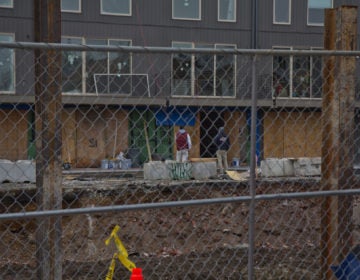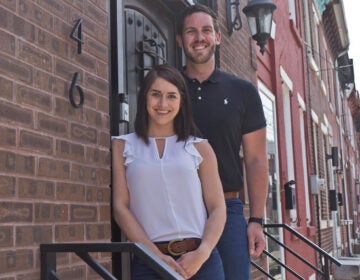Who benefits most from Philly’s tax abatement? Center City developers
The lion’s share of revenue lost to Philly’s tax abatement is tied to large commercial real estate projects, not single-family homes.

An Eagles fan takes in the city from the top of the steps to the Philadelphia Museum of Art, also known as the Rocky steps. (Emma Lee/WHYY)
When Philadelphians think about the city’s 10-year tax abatement, many picture the ostentatious mega-rowhouses that have sprouted in historically working-class neighborhoods, igniting controversy along the way.
But if residents want to see where most of those tax breaks are going, they might be better off looking at the downtown skyline.
Just 1,700 structures, mostly concentrated in the city’s commercial core, will account for $6.39 billion in abated tax value next year. That’s more than half of the $12.43 billion total abated in the fiscal year, according to the city’s 2020 property tax revenue projections.
Most of these properties are apartment buildings, hotels or large commercial and industrial properties.
The 13,900 other buildings that received the abatement, mostly rowhouses or other single-family homes, added up to a smaller $5.19 billion in abated tax value.
“A new townhome gets built in a working-class, rowhome neighborhood, and they’re getting the abatement, and it’s a three-story home on a block that’s all two-story, and they’re gentrifying the neighborhood. That’s the most visible abated property to the average Philadelphian,” said economist Kevin Gillen, a Building Industry Association of Philadelphia board member. “But the reality is that most of the abated properties are heavily concentrated in and around Center City. And they’re mostly commercial or multifamily.”
The $12.43 billion in abated value translates into an estimated $109 million in actual property tax revenue that will be forgone by the city and school district next year, according to city projections.
Gillen, who has studied the abatement, said its concentration in Center City reflects larger real estate trends. The biggest and most highly capitalized real estate development projects tend to be built near downtown areas. And, over the past decade, the market for larger, multifamily developments has grown.
But the most recent projections reflect trends going back to 2000, when the program was born.
A 2018 report by City Controller Rebecca Rhynhart found that over the life of the abatement, its tax benefits have overwhelmingly gone to commercial developers and property owners. While commercial properties accounted for 2% of total abated properties between 2000 and 2017, they received 11% of the total tax benefit.
A whopping 59% of the tax benefit for active abatements in that period went to Center City and the surrounding nine neighborhoods. Rittenhouse alone accounted for 19% of total tax benefits, according to Rhynhart’s analysis.
Critics of the 10-year tax abatement, like Alison Stohr, said these findings only underscore the policy’s failings. Stohr has worked as an organizer with the 215 People’s Alliance, which has been behind public calls to reform or abolish the abatement.
“It’s frustrating that people who are able to build huge amounts of construction are getting it. These are people who can afford to pay property tax,” Stohr said.
Gillen countered that the city needs the abatement to bridge the gap in between relatively high construction costs and relatively low sale or rental prices, in many neighborhoods. He generally credits the policy with “expanding the city’s tax base” in the long run by encouraging development.
“The abatement has become a punching bag, damned if it does and doesn’t,” Gillen said. “If it results in new housing in working-class neighborhoods, it’s damned as gentrification. If it’s only used for high-rise, high-priced neighborhoods in and around Center City, it’s damned for being elitist and exclusive.”
Still, Gillen said the city could do more to market the abatement to ordinary homeowners, who may qualify for a tax break simply by investing in everyday home improvements. And he said it could be worth exploring the legality of more targeted versions of the abatement.
For instance, Bethlehem, Pa. has experimented with tax incentive districts, instead of the current citywide program.
City Council members have introduced bills to alter or eliminate the abatement in the last three Council sessions, but none have received a hearing. Councilmembers including Allan Domb and Helen Gym say that they want to see reform efforts move forward before 2020, when a new City Council will be seated.
Correction: Due to an editing error, the original version of this story misstated when Philadelphia started its tax abatement. The error was corrected.
WHYY is your source for fact-based, in-depth journalism and information. As a nonprofit organization, we rely on financial support from readers like you. Please give today.







